Papers by Manuel Sebastián

Previous research on emotion in language has mainly concerned the impact of emotional information... more Previous research on emotion in language has mainly concerned the impact of emotional information on several aspects of lexico-semantic analyses of single words. However, affective influences on morphosyntactic processing are less understood. In the present study, we focused on the impact of negative valence in the processing of gender agreement relations. Event-related potentials (ERPs) were recorded while participants read three-word phrases and performed a syntactic judgment task. Negative and neutral adjectives could agree or disagree in gender with the preceding noun. At an electrophysiological level, the amplitude of a left anterior negativity (LAN) to gender agreement mismatches decreased in negative words, relative to neutral words. The behavioral data suggested that LAN amplitudes might be indexing the processing costs associated with the detection of gender agreement errors, since the detection of gender mismatches resulted in faster and more accurate responses than did the detection of correct gender agreement relations. According to this view, it seems that negative content facilitated the processes implicated in the early detection of gender agreement mismatches. However, gender agreement violations in negative words triggered processes involved in the reanalysis and repair of the syntactic structure, as reflected in larger P600 amplitudes to incorrect than to correct phrases, irrespective of their emotional valence.

For the first time this study measures the electric brain activation in a semi-real scenario to i... more For the first time this study measures the electric brain activation in a semi-real scenario to investigate the representation of objects in the near/far space. We recorded electrical brain activity from a group of 22 participants who had to indicate whether or not they could reach or not several objects that appeared along a 52” touchscreen display. We replicated previous results showing that reaction time to objects located in the near space was significantly faster than to objects located in far space. The effects of object location found here were significant even when their hand was not visible to them and retracted from the objects. ERP analysis showed a consistent N1 visual component with faster latencies and greater amplitudes for objects in near space. Importantly, this latency difference was not linked only to the physical distance but to a psychological division between near and far space based on their interactive potential (e.g. reachable vs. not reachable). At later stages LPP results showed significant effects of arousal at occipital electrode sites while parietal scalp locations were sensitive to spatial location supporting a ventral/dorsal dissociation of neuropsychological space.
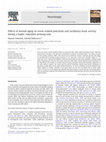
This study reports neural repetition effects in young and older adults while performing a haptic ... more This study reports neural repetition effects in young and older adults while performing a haptic repetition priming task consisting in the detection of the bilateral symmetry of familiar objects. To examine changes in event-related potentials (ERPs) and induced brain oscillations of object repetition priming with aging, we recorded EEGs of healthy groups of young (n=14; mean age=29.93years) and older adults (n=15; mean age=66.4). Both groups exhibited similar behavioral haptic priming across repetitions, although young adults responded faster than the older group. Young and older adults showed ERP repetition enhancement at the 500-900ms time window. In contrast, only the young participants showed ERP repetition suppression at the 1200-1500ms segment. The results from the induced oscillations showed more positive amplitudes in young than in older adults at theta, alpha and beta frequencies (4-30Hz). In addition, we found amplitude modulation related to stimulus repetition in the upper alpha and low beta sub-bands only in young adults (1250-1750ms).The results suggest that although behavioral priming is spared with age, normal aging affects ERPs and oscillatory responses when performing an incidental priming symmetry detection task with haptically explored objects.
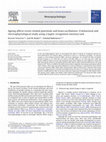
In this electrophysiological study, we investigated the effects of ageing on recognition memory f... more In this electrophysiological study, we investigated the effects of ageing on recognition memory for three-dimensional (3D) familiar objects presented to touch in a continuous paradigm. To examine changes in event-related potentials (ERPs) and brain oscillations, we recorded the EEGs of healthy groups of young (n=14; mean age=32.3 years) and older adults (n=14; mean age=65.1). Both age groups exhibited similar accuracy and exploration times when making old-new judgments. Young and older participants showed a marginally significant ERP old/new effect widely distributed over the scalp between 550-750 ms. In addition, the elders showed lower amplitude than younger participants within 1200-1500 ms. There were age-related differences in brain oscillations as measured by event-related spectral perturbation (ERSP). Older adults showed greater alpha and beta power reductions than young participants, suggesting the recruitment of additional neural resources. In contrast, the two age groups showed a reliable old/new effect in the theta band that temporarily overlapped the ERP old/new effect. The present results suggest that despite similar behavioral performance, the young and older adults recruited different neural resources to perform a haptic recognition task.
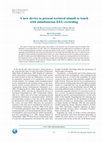
The study of touch has recently grown, due mainly to the extensive use of several types of actuat... more The study of touch has recently grown, due mainly to the extensive use of several types of actuators that stimulate several subsystems of touch. There is a widespread interest in applying these mechanisms to the study of the neurophysiological correlates of tactual perception. In this article, we present a new device (the tactile spinning wheel [TSW]) for delivering textured surfaces to the finger pad. The TSW allows one to control several parameters of the stimulation (angular speed, texture, etc.) and, connected to an EEG recording system, makes it possible to study neural electrophysiological events. The device consists of a rotating platform on which the tactile stimuli are fixed, a system that synchronizes stimuli onset with the EEG system, and an electronic interface that controls the platform. We present the technical details of the TSW, its calibration, and some experimental results we have obtained with this device.

The present study investigated low-oscillatory (theta band, 3-7 Hz) modulations induced by tactil... more The present study investigated low-oscillatory (theta band, 3-7 Hz) modulations induced by tactile roughness stimulations under two attention demanding conditions. Four levels of roughness were presented under low demanding and high-demanding conditions. In both conditions, an oddball paradigm was used to present three target surfaces varying in roughness (low, mid, and high levels of roughness), and a nontarget flat surface. The results showed that centro-parietal theta oscillations are involved in allocating attentional resources when participants have to update new information induced by incoming haptic stimuli. Theta power was higher in the high-demanding task compared to the low-demanding. Furthermore, theta power varied depending on tactile roughness but not in a linear manner. This was interpreted as that theta oscillations were sensitive not only to task difficulty but also to physical properties.
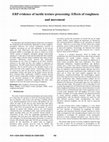
Psychological and neurophysiological studies have investigated the peripheral neural mechanisms i... more Psychological and neurophysiological studies have investigated the peripheral neural mechanisms implicated in tactile roughness perception. However, the cortical mechanisms involved in roughness processing are not well understood. In the present study, we used behavioural data and event-related evoked potentials (ERPs) to investigate the extent to which two tactile stimuli varying in roughness (triangular gratings peak-to-peak spacing of 1.6 mm and 2.8 mm) and movement (the time available for tactile contact with the surface) modulate early stages of brain activation. Behavioral results showed that participants discriminate the two levels of roughness at the three velocities explored in the study but they were judged as equivalent in pleasantness. The ERP results showed a biphasic early-fast N1-P2 deflection. The N1 and P2 peaks to the smoother texture occur earlier than that of the rougher texture. Considering velocity, the N1 onset occurs later for the slowest velocity, followed by the intermediate velocity and earlier for the fastest velocity and the three velocities differ significantly. LORETA analysis showed that N1 and P2 components of surface roughness are both related to the activation produced in the somatosensory cortex and posterior cingulated respectively, suggesting that these areas might be involved in the sensory processing of roughness.

Lecture Notes in Computer Science
We investigated the effect of different types of interference in visual and haptic working memory... more We investigated the effect of different types of interference in visual and haptic working memory using a dual-task paradigm. At encoding, 16 young adults performed both, a haptic and a visual primary task followed by the performance of a secondary interference task during a retention interval. The interference task could be a haptic (spatial), visual (spatial), auditory, or control (visual-static) task. The idea was to study the influence of spatial and verbal interference on working memory for spatial targets encoded visually or haptically. The results indicated that the auditory interference task did not deteriorate performance compared to the control condition in which participants performed the visual-static task. The negative effects of spatial interference increased when both the primary and secondary tasks were performed using the same modality. Spatial interference selectively deteriorated both visual and haptic working memory but more strongly the later.
Conference Presentations by Manuel Sebastián

Aging is a complex phenomenon that affects all individuals. We report results from a study in whi... more Aging is a complex phenomenon that affects all individuals. We report results from a study in which young and older participants (healthy adults and mild cognitive impaired elders-MCI) were assessed in a series of cognitive tasks. Young adults performed better than older adults in executive-control and speeded processing tasks but not in a repetition priming task for attended and unattended stimuli at encoding. The MCI group performed worse in all tasks and did not show repetition priming effects. There is evidence that an engaged and active lifestyle enhance cognitive functioning (Hertzog et al., 2009; Park et al., 2007). Here, we investigate the effectiveness of social integration, connectivity, and mental stimulation through a user-sensitive home-based information computing technology (ICT) environment and a web-based social networking system (AGNES) to compensate cognitive losses in later adulthood. Reducing social isolation and providing stimulating and active environments are expected to preserve and/or improve cognitive and brain functioning, especially of those processes that suffer more with aging. Cognitive-enrichment effects will be discussed.

Ageing is a complex phenomenon that affects the mind and brain of all individuals. In this study,... more Ageing is a complex phenomenon that affects the mind and brain of all individuals. In this study, we used new cutting-edge information computing technology to test the idea that an active lifestyle rich in social interactions and active cognitive engagement may mitigate age related declines. The web-based social network platform, enhanced with devices to detect users´ states and collect activity data is the core of the AGNES (an EC-AAL Joint Program and MICINN Project) modular system that is being tested in Spain, Sweden and Greece. Its effectiveness to maintain cognitive processes that decline in the old age (speed of processing, executive control and memory), brain function and wellbeing is assessed throughout the project. User interviews, extensive cognitive testing and brain imaging experiments are conducted with experimental and control groups to clarify whether a cognitive active and socially engaged life maintain those cognitive and brain functions that deteriorate most with age.
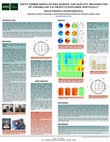
The ongoing electroencephalogram (EEG) consists of oscillatory components that can be characteriz... more The ongoing electroencephalogram (EEG) consists of oscillatory components that can be characterized in terms of frequency and amplitude. Brain oscillations in different frequency bands reflect different aspects of sensorial and cognitive processing (e.g, Basar et al., 2001). Power enhancements in the human EEG have been previously reported in theta band (4-7Hz.) during the haptic exploration of unfamiliar 2D raised-line patterns (Grunwald, 1999, 2001). In the context of haptic recognition, these dynamic changes in spectral power have been related to memory load, with lower theta power at the beginning compared to the end of exploration (Grunwald, 2001). In the present electrophysiological study, we investigated theta power modulations in a group of 16 young adults during the haptic exploration of three-dimensional (3D) unfamiliar objects. We used a continuous old-new recognition paradigm while recording the EEG activity to measure event-related spectral perturbation (ERSP). This method uses average dynamic changes in the amplitude of the broadband frequency spectrum as a function of time relative to an experimental event (Makeig, 1993).

Aging Clinical and Experimental Research, 23, suppl. to No. 1 Feb. 2011, p. 113
Ageing is a complex process that affects the mind and brain of all individuals1. The ageing of th... more Ageing is a complex process that affects the mind and brain of all individuals1. The ageing of the population is leading to a growing number of elders living alone and in need of care as loneliness increases risk of cognitive decline. The aim of AGNES (an EC-AAL Joint Program and MICINN project) is to prevent and/or delay chronic conditions, maintaining independence and wellbeing of the elders2 by integrating a novel home-based cutting-edge ICT approach with social networks to connect the elders with family, friends and carers. An active lifestyle rich in social interactions and active engagement may mitigate age-related decline and reduce healthcare costs. The web-based social network platform, enhanced with devices to detect users´ states and collect activity data is the core of the AGNES modular system that is being tested in Spain, Sweden and Greece. Its effectiveness to maintain cognitive processes (speed of processing, executive control and memory), brain functions and wellbeing is assessed throughout the project. Users are intensively involved to assure acceptance of the system. Interviews with end-users evaluate the acceptance of the various components of AGNES and guide technicians in developing the system. User interviews, case scenarios, extensive psychological testing and cognitive and fMRI experiments are conducted with experimental and control groups to clarify whether a more active and socially engaged life maintains those functions that deteriorate most with age. Final results of this ongoing scientific response to the need of a large number of elderly people living alone, but in need of social support to maintain cognitive health and physical wellbeing will be obtained in two years.
Behavioral repetition priming for objects explored by touch is preserved in healthy aging and in ... more Behavioral repetition priming for objects explored by touch is preserved in healthy aging and in Alzheimer´s disease patients (Ballesteros & Reales, 2004). Neural repetition enhancements (RE) and reductions (RR) for repeated objects relative to its first presentation have been reported in vision: An early RE has been found consistently between 300–700ms with study-test tasks (e.g., Penney, Mecklinger, Hilton & Cooper, 2000). An additional RR has been observed within 500-900ms in studies without fixed retention intervals (e.g., Penney et al., 2001). Based on the idea that the brain is metamodal (e.g., Pascual-Leone & Hamilton, 2001), we predict similar neural effects in the haptic modality.

Abstracts of the International Conference ‘‘Aging & Cognition’’. Journal of Psychophysiology 2011; 25(Suppl. 1), 1–5
Declines in many cognitive functions occur in older adults, including selective attention, execut... more Declines in many cognitive functions occur in older adults, including selective attention, executive control, processing speed, and episodic (explicit) memory. However, a wealth of behavioral studies have shown that implicit memory assessed by showing repetition priming using different tests (e.g., speeded object naming, word fragment completion, perceptual classification) and a variety of stimuli (e.g., words, pictures, objects, sounds) presented at several perceptual modalities (e.g., vision, touch, audition) appears stable with age. The question we asked here is whether the neural correlates supporting implicit memory are also preserved in older adults. Results from electrophysiological and brain imaging studies suggest that older adults compensate their lower level of parieto-occipital functioning by recruiting anterior frontal sites. The relationships between brain function and behavior found in young adults are altered in older adults. Our results suggest that with aging there are changes in the neural architecture that mediate repetition priming.

The present study investigated low-oscillatory (theta band, 3-7 Hz) modulations induced by tactil... more The present study investigated low-oscillatory (theta band, 3-7 Hz) modulations induced by tactile roughness stimulations under two attention demanding conditions. Four levels of roughness were presented under low demanding and high-demanding conditions. In both conditions, an oddball paradigm was used to present three target surfaces varying in roughness (low, mid, and high levels of roughness), and a nontarget flat surface. The results showed that centro-parietal theta oscillations are involved in allocating attentional resources when participants have to update new information induced by incoming haptic stimuli. Theta power was higher in the high-demanding task compared to the low-demanding. Furthermore, theta power varied depending on tactile roughness but not in a linear manner. This was interpreted as that theta oscillations were sensitive not only to task difficulty but also to physical properties.

We studied how stimulation patterns presented to the skin are processed by the brain and how memo... more We studied how stimulation patterns presented to the skin are processed by the brain and how memories can affect the resulting perceptions. The first series of studies investigated brain activity associated with the perception and attention of texture patterns varying in roughness using event-related evoked potentials (ERPs) while perceivers explored with the fingertip target and a non-target textured stimuli moving below under different conditions. We also studied transient modulations in tactile attention, related to physical and contextual factors. Textures were mounted on the Tactile-Spinning Wheel, a specifically designed apparatus that allow electrophysiological recordings. We found an increased P300-like component for attended compared to unattended stimuli and synchronization in the theta band (3-7 Hz) at an early 200 ms time window (around 200 ms), followed by desynchronization in the alpha band (8-12 Hz) at the 400-800 ms time window. Source analysis using LORETA showed higher neural activation when processing targets compared to standard stimuli at somatosensory, occipital, and frontal cortices. The second series of experiments investigated the brain activation patterns of repetition priming of familiar and unfamiliar novel objects explored by touch. We found behavioral facilitation for old compared to new stimuli that increased with repetitions. More interestingly, repeated object presentation induced gamma frequency (>20Hz) synchronization. The findings suggest that a new cell-assembly representing the object features is created with repetition.
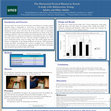
Previous studies have shown that the horizontal–vertical illusion for tactually explored raised-l... more Previous studies have shown that the horizontal–vertical illusion for tactually explored raised-line shapes is independent of visual status or visual imagery, since similar illusory overestimation of the vertical occurs in early blind, later blind, and low-vision participants (Heller et al., 2003) and occurs with curves (Heller et al., 2008). In the present study, we investigated whether this spatial misperception changes from adolescence to old age. In the study, participants explored a series of horizontal and vertical raised-line curves of different sizes. Exploration was unimanual or bimanual in counterbalanced order. Curve height was always equal to width at the base. The task consisted of judging the size of the curves (horizontal/vertical), using two sliding rulers. The results suggest that the illusion is independent of age, and participants overestimated the vertical in tangible curves.







Uploads
Papers by Manuel Sebastián
Conference Presentations by Manuel Sebastián